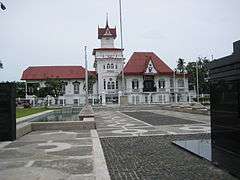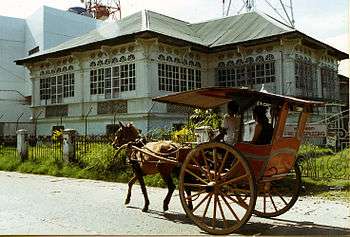Ancestral houses of the Philippines

Ancestral houses of the Philippines are homes owned and preserved by the same family for several generations as part of the Filipino family culture.[1] Houses could be a simple house to a mansion. Some houses of prominent families had become points of interest or museums in their community because of its cultural, architectural or historical significance.[2][3] These houses that are deemed of significant importance to the Filipino culture are declared Heritage House by the National Historical Commission of the Philippines (NHCP), previously known as the National Historical Institute (NHI) of the Philippines.[4] Preservation is of utmost importance as some ancestral houses have come into danger due to business people who buy old houses in the provinces, dismantle them then sell the parts as ancestral building materials for homeowners wishing to have the ancestral ambiance on their houses.[5] These ancestral houses provide the current generation a look back of the country's colonial past through these old houses.[6]
National Cultural Heritage Act of 2009
In 2009, the Congress of the Philippines passed the National Cultural Heritage Act of 2009 or Republic Act. no. 10066 to further the protection the cultural treasures of the country which include houses under Built heritage. Ancestral houses that are declared Heritage House by the NHCP are still owned by their owners. The government is only declaring the heritage value of the structure, provide funding for its protection and preservation.[7] Ancestral homes that have figured in an event of historical significance like the Bonifacio Trial House in Maragondon, Cavite,[8] or houses of national heroes of the Philippines like the Juan Luna Shrine[9] in Badoc, Ilocos Norte are included among the categories National Shrines or National Historical Landmarks.[10][11] Historical markers are placed on the houses by the commission to indicate their significance.[12] The Philippine Registry of Cultural Property registers all cultural properties of the country.[11]
List of Heritage Houses of the Philippines
Partial list of ancestral houses declared as Heritage Houses by the NHCP, some with declaration dates, grouped according to the regions in the country.[13]

Region I
In the Ilocos Region the historic city of Vigan is the best preserved Spanish Colonial settlement in the country. It was declared as a UNESCO World Heritage Site in 1999.
- Syquia Mansion in Vigan, Ilocos Sur, home of former president Elpidio Quirino
Region III
In Central Luzon, There are two historical town centers declared by National Historical Commission of the Philippines as historic town centers in the region namely the Malolos Heritage Town in Bulacan[14] declared in August 15, 2001 and City of San Fernando Heritage District in Pampanga declared in 2004.[15]
Malolos Heritage Town NHL
- Doña Alberta Uitancoy Mansion, Calle FT Reyes, Malolos, Bulacan
- Don Hermogenes Reyes Mansion, Calle FT Reyes, Malolos, Bulacan
- Gobierno Militar de la Plaza, Calle Pariancillo, Malolos, Bulacan now MERALCO Malolos Office.
- Don Antonio Bautista Mansion, Calle Paseo del Congreso, Malolos, Bulacan oldest house existing in Malolos.
- Don Jose Bautista Mansion, Calle Sto Niño, Malolos, Bulacan
- Don Ramon Gonzales de Leon House, Calle Cigarillera, Malolos, Bulacan
- DR.Luis Uitangcoy Santos Mansion, Calle FT Reyes, Malolos, Bulacan
- Guillermo E.Tolentino House, Calle Sabitan, Malolos, Bulacan with NHCP marker.
- Don Arcadio Ejercito Mansion, Calle Pariancillo, Malolos, Bulacan
- Don Erastro Cervantes House, also known as Secretaria de Guera,Calle Pariancillo, Malolos, Bulacan
- Don Jose Chichioco-Cojuangco Mansion, Calle Paseo del Congreso, Malolos, Bulacan with NHCP marker.
- Don Fausto Chiong Mansion, Calle Pariancillo, Malolos, Bulacan
- Mariano Crisostomo, Calle Estrella, Malolos, Bulacan Don Mariano is uncle of Marcelo H.Del Pilar.
- Pineda House, Calle Jarino, Malolos, Bulacan
- 1930 Lomotan-Jacinto, Calle Sto Nino, Malolos, Bulacan
San Fernando Heritage Zone San Fernando, Pampanga
- Augusto P. Hizon House in San Fernando, Pampanga
- Dayrit-Cuyugan House in San Fernando, Pampanga (2003-01-27)[15]
- Henson-Hizon House in San Fernando, Pampanga (2003-01-27)
- Hizon-Singian House in San Fernando, Pampanga (2003-01-27)
- Lazatin House in San Fernando, Pampanga (2003-01-27)

National Capital Region
The central part of Metro Manila was heavily bombed in World War II destroying historical structures and homes. Somes pockets of old homes can still be found in Binondo and Quiapo which were not affected by the war.[16]
- Casa Consulado in Quiapo, Manila
- Lichauco Residence in Santa Ana, Manila
- Mira-Nila House Cubao, Quezon City
Region IV-A
In the CALABARZON region, the center for ancestral houses can be found in the streets of Taal, Balayan, and Calaca, in Batangas and Sariaya in Quezon provinces. The town center of Pila, Laguna, with its Spanish and American-era houses, was declared a National Historical Landmark in 2000.
- Gala-Rodriguez House in Sariaya, Quezon
- Natalio Enriquez House in Sariaya, Quezon
- Don Catalino Rodriguez Ancestral House in Sariaya
- Luz-Katigbak House in Lipa, Batangas
- Sarayba House in General Trias, Cavite
- Goco House in Taal, Batangas
- Ylagan-de la Rosa House in Taal, Batangas
Region IV-B
Declared Heritage House in MIMAROPA region.
- Casa Narvas in Boac, Marinduque, Marinduque
Region XVIII/NIR
Bacolod City, Negros Occidental in the Negros Island Region, is the provincial capital and contains a number of fine ancestral homes.
- Generoso Villanueva House, known as "Daku Balay" (Big House), is one of the finest examples of Art Deco architecture in the Philippines from the 1930s.
Silay City
Silay City, Negros Occidental in the Negros Island Region has the most number of declared Heritage Houses in the country.

- Alejandro Amechazura House
- Amelia Hilado Flores House
- Angel Araneta Ledesma House
- Augusto Hilado Severino House
- Benita Jara House
- Bernardino Lopez Jalandoni Ancestral House
- Carlos Arceo Ledesma House
- Claudio Hilado Akol House
- Delfin Ledesma House
- Digna Locsin Consing House
- Dr. Jose Corteza Locsin House
- Felix Tad-y Lacson House
- Generoso Reyes Gamboa House
- German Lacson Gaston House
- German Locsin Unson House
- Jose Benedicto Gamboa House
- Jose Corteza Locsin House
- Jose Ledesma House
- Kapitan Marciano Montelibano Lacson House
- Manuel de la Rama Locsin House
- Manuel Severino Hofileña House
- Maria Ledesma Golez House
- Modesto Ramirez Hojilla (Carlos Javelosa Jalandoni) House
- Severino Building/Heritage House
- Soledad and Maria Montelibano Lacson House
- Teodoro Morada House
- Vicente Conlu Montelibano House
- Victor Fernandez Gaston House or Balay Negrense
Other Heritage Houses in Region XVIII/NIR
- Infante House in La Carlota City, Negros Occidental
Region VI
Heritage Houses in Western Visayas region:
- Lopez House in La Paz, Iloilo City, Iloilo
- Roca Encantada House in Buenavista, Guimaras
Region VII
Heritage Houses in Central Visayas region:
- Balay na Tisa Heritage House in Carcar, Cebu
- Clarin Ancestral House in Loay, Bohol
- Mercado Mansion in Carcar, Cebu
- President Carlos P. Garcia Heritage House in Tagbilaran, Bohol
- Sa Dakong Balay / Don Florencio Noel House in Carcar, Cebu
- Yap-Sandiego Heritage House in Cebu City
- Silva House in Carcar, Cebu
Region VIII
Heritage Houses in the Eastern Visayas region:
- Oppus Ancestral House now the Southern Leyte Provincial Library in Maasin, Southern Leyte
Region X
Heritage Houses in the Northern Mindanao region:
- Macapagal-Macaraeg House im Iligan City, Lanao del Norte
National Shrines and National Historical Landmarks
Partial list of ancestral houses declared as National Shrine or National Historical Landmark by the NHCP:[10][13]

- Aguinaldo Shrine in Kawit, Cavite
- Apolinario Mabini Shine in Tanuan, Batangas
- Apolinario Mabini Shrine in Pandacan, Manila
- Aquino Ancestral House Historical Landmark in Concepcion, Tarlac[17]
- Baldomero Aguinaldo Shrine in Binakayan, Kawit, Cavite
- Juan Luna Shrine in Badoc, Ilocos Norte
- Marcela Agoncillo Historical Landmark in Taal, Batangas
- Rizal Shrine, Calamba, Laguna
- Rizal Shrine in Dapitan City, Zamboanga del Norte
Other ancestral houses
- Consunji House in San Fernando, Pampanga
- Mariano Ramos Ancestral House in San Fernando, Pampanga
- Quema House in Vigan, Ilocos Sur
- Tabacalera House in San Fernando, Pampanga
- Atega Ancestral House in Cabadbaran City, Agusan del Norte
- Villavicencio's Ancestral and the Wedding Gift House in Taal, Batangas[6]
References
- ↑ "Filipino Culture" Archived November 30, 2011, at the Wayback Machine.. Filipino Planet. Retrieved on 2011-10-26.
- ↑ "Best Filipino Ancestral Houses". Traveler on Foot. Retrieved on 2011-10-17.
- ↑ Tacio, Henrylito D. (2010-10-12). "Ancestral Home in the City" Archived October 29, 2010, at the Wayback Machine.. Manila Bulletin. Retrieved on 2011-10-26.
- ↑ "Republic Act No. 10066 - National Cultural Heritage Act of 2009". Ivan about Town. Retrieved on 2010-10-27.
- ↑ Henares, Ivan (2006-07-19). "Stop the sale of ancestral homes!". Ivan about Town. Retrieved on 2011-10-29.
- 1 2 "Villavicencio's Ancestral House: Taal's Gift House". Lantaw. Retrieved on 2011-10-29.
- ↑ (2010-09-03). "No ownership change in ‘RA 10066 declaration’". Inquirer.net. Retrieved on 2011-10-26.
- ↑ "Bonifacio Trial House". National Historical Commission. Retrieved on 2011-10-27.
- ↑ "Juan Luna Shrine". National Historical Commission. Retrieved on 2011-10-27.
- 1 2 "Shrines and Landmarks". National Historical Commission of the Philippines. Retrieved on 2011-10-26.
- 1 2 Bonvito (2010-04-23). "Text of the Philippine National Cultural Heritage Law". Time Traveling. Retrieved on 2010-10-26.
- ↑ "Touring the Ancestral Houses of Silay, Negros Occidental". Travelog Philippines. Retrieved on 2011-10-26.
- 1 2 (2010-04-01). "Philippine Registry of Cultural Property - Built Heritage". Ivan About Town. Retrieved on 2011-10-26.
- ↑ http://nhcphistoricsites.blogspot.com/2011/10/town-center-of-malolos.html?m=1
- 1 2 (2005-04-15). "San Fernando: a city rich in architectural heritage". Indung Kapampangan: Preserving our Kapampangan Heritage. Retrieved on 2011-10-29.
- ↑ Gardner, Robert (2006–04). "Philippine architecture from bahay kubo to bahay na bato". derkeiler.com. Retrieved on 2011-10-29.
- ↑ Philippine News Agency (2011-09-11). "Historical marker on Aquino ancestral house in Tarlac unveiled". News 5 InterAksyon. Retrieved on 2011-10-27.
External links
- Partial list of Philippine Registry of Cultural Property under Built Heritage
- Other Ancestral houses from the Historical Conservation Society.